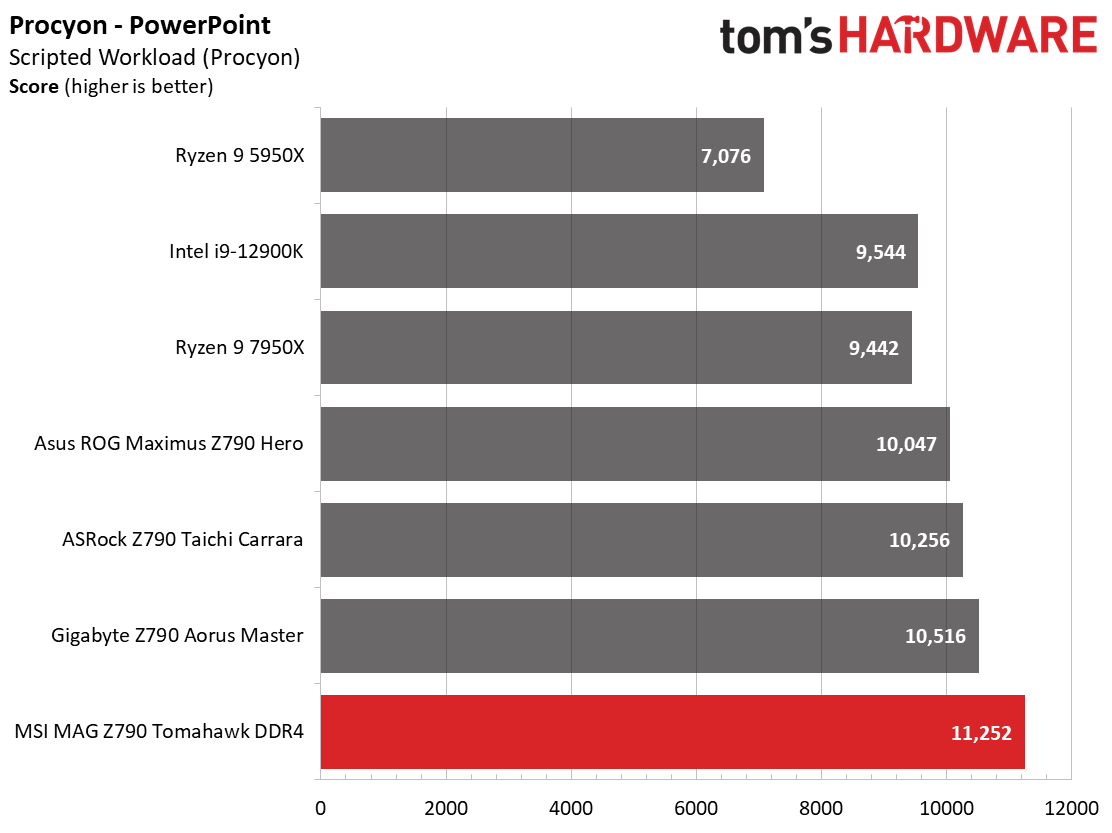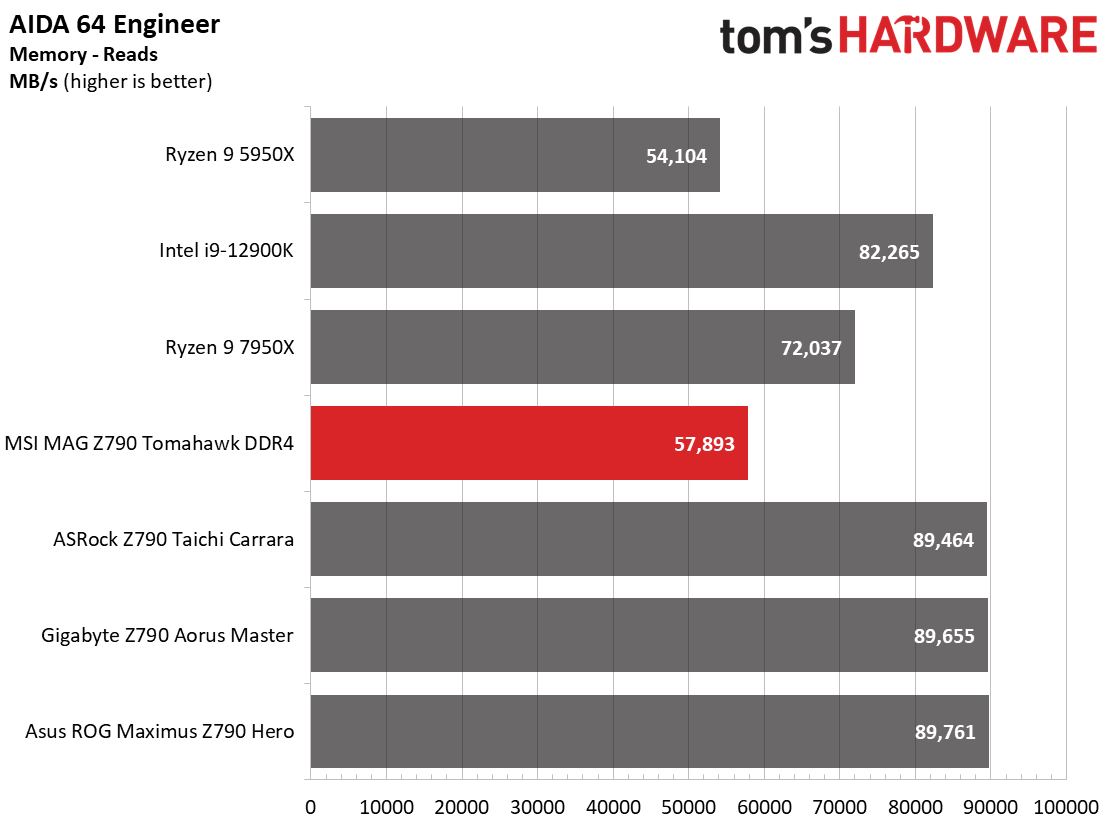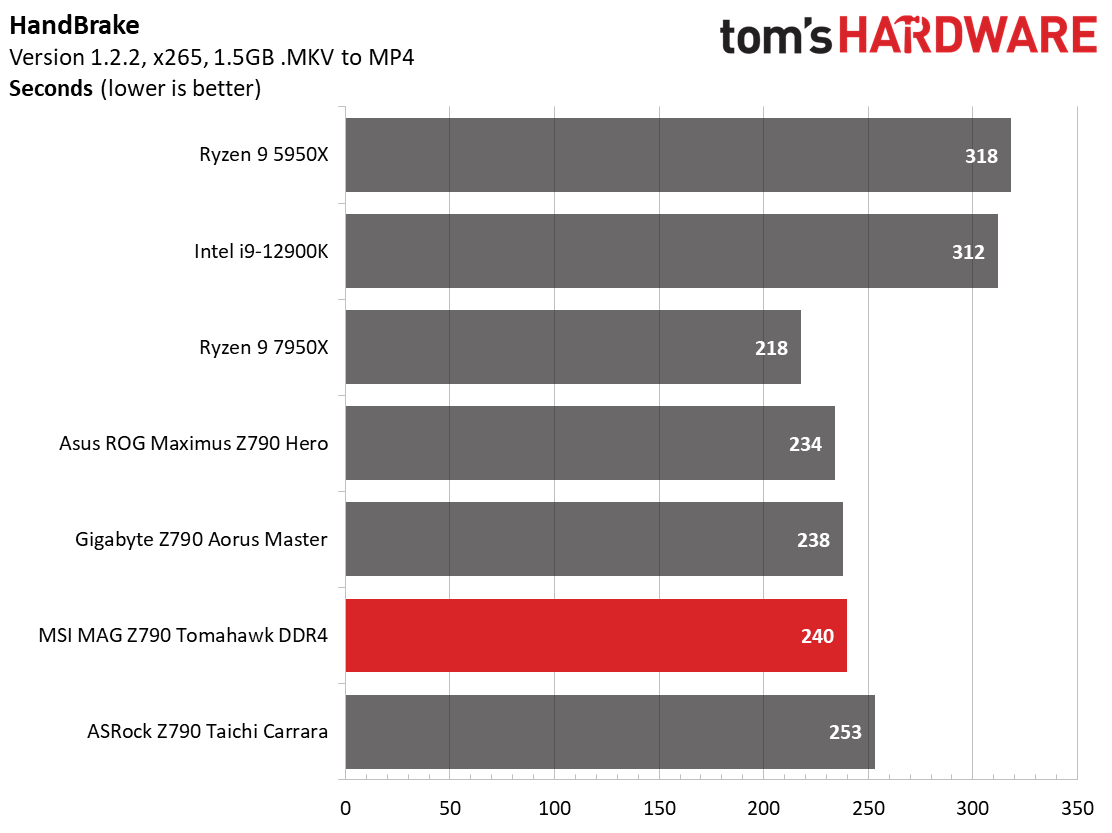Why you can trust Tom's Hardware
Our standard benchmarks and power tests are performed using the CPU’s stock frequencies (including any default boost/turbo), with all power-saving features enabled. We set optimized defaults in the BIOS and the memory by enabling the XMP profile. For this baseline testing, the Windows power scheme is set to Balanced (default) so the PC idles appropriately.
Synthetic Benchmarks
Synthetics provide a great way to determine how a board runs, as identical settings should produce similar performance results. Turbo boost wattage and advanced memory timings are places where motherboard makers can still optimize for either stability or performance, though, and those settings can impact some testing.


















Across our synthetic benchmarks, the Tomahawk is the fastest in some and the slowest in others. But like most results (that aren’t affected by DDR4 heavily like the 7Zip compression test) the peaks and lulls are difficult to notice unless you’re specifically looking for them. Performance is right up there with the others across most tests.
Timed Applications




In the LAME benchmark, the Tomahawk was middle of the pack, but it was the fastest in Corona (by one second, minimal difference). During the Handbrake x264 testing, MSI’s board was the slowest by a couple of seconds, while the x265 test showed one of the faster results. We found nothing anomalous in the timed applications.
3D Games and 3DMark




Starting with the launch of Zen 4, we’ve updated one of our games, F1 21 to F1 22, while keeping Far Cry 6. We run the games at 1920x1080 resolution using the Ultra preset (details listed above). As the resolution goes up, the CPU tends to have less impact. The goal with these settings is to determine if there are differences in performance at the most commonly used (and CPU/system bound) resolution with settings most people use or strive for (Ultra). We expect the difference between boards in these tests to be minor, with most falling within the margin of error differences. We’ve also added a minimum FPS value, which can affect your gameplay and immersion experience.
The Tomahawk is a more than competent gaming board. The 3D mark results both landed in the middle of the other three data sets while it lead the pack in our Far Cry 6 benchmark in both minimum and maximums (though only by a frame on minimums) and tied for the fastest result in F1 2022. Here again, all of the results are close, and difficult notice a difference beyond benchmarks and frame counters.
Overclocking
When overclocking, we aim to increase the power and add stress to the VRMs. We do so by increasing the clock speed and voltage until we’re at the thermal threshold for the processor during stress testing. However, where these CPUs are allowed to run with ‘boost’ speeds, those speeds are closer to the limit than ever before.
Get Tom's Hardware's best news and in-depth reviews, straight to your inbox.
With our i9-13900K, the approach was a bit different. We had to lower the voltage from what we recorded during stress tests to overclock our chip. We increased the clock speeds of the “P” and “E” cores by 100 MHz and 200 MHz, respectively, over the turbo boost and limited by our cooling. We ended up with 5.6 GHz P core and 4.5 GHz E core clocks using about 1.34V (from DMM). Temperatures peak just under the throttling point with this configuration. And as we’ve noted elsewhere, this is the intended performance for Intel’s flagship CPU.
Overclocking on the Tomahawk was the easiest of our tested boards so far. We set 1.35V in the BIOS with LLC (Load Line Calibration) set to 2, and the load voltage in Windows matched what was set in the BIOS. The board then ran stable and didn’t throttle using the same or less power than the out-of-the-box settings.
We had no issues with both memory kits. We used the latest BIOS, running them stable throughout our testing. The Tomahawk’s DDR4-5333 MHz is one of the higher ratings listed, so there’s plenty of headroom for those who want to push past DDR4’s performance sweet spot.
Power Consumption / VRM Temperatures
We used AIDA64’s System Stability Test with Stress CPU, FPU, Cache and Memory enabled for power testing, using the peak power consumption value. The wattage reading is from the wall via a Kill-A-Watt meter to capture the entire PC (minus the monitor). The only variable that changes is the motherboard; all other parts remain the same. Please note we moved to use only the stock power use/VRM temperature charts, as the goal of this section is to ensure the power delivery can handle the chip even when overclocked. Since we’re using less power to get more clocks, those datasets are more novel than useful. We’re also temperature limited on the processor, so adding more power isn’t possible without increased throttling.
Idle power consumption for the Z790 Tomahawk was 62 watts (the lowest so far), while the load power use was 381 watts, several more than the Z790 Aorus Master (but nowhere close to the Taichi’s 498W number). It’s still early, but we expect the Tomahawk’s numbers to be around average after we get more data sets.


VRM temperatures on our board peaked at almost 58 degrees Celsius, just below the 500W actively cooled Taichi and around 10-plus degrees hotter than the Aorus Master and Hero. These temperatures are well within the specifications of the power delivery bits, so there’s nothing to worry about on this front. The combination of 90A SPS MOSFETs and the ample heatsinks is a great match.
Editor's Note 12/15/2022: After contacting MSI about an error on the webpage, they confirmed the power delivery on the Tomahawk (DDR4 and DDR5) is actually a "mirrored" configuration using Renesas ISL6617A phase doublers.
Bottom Line
MSI’s MAG Z790 Tomahawk WIFI DDR4 presents builders with a less expensive way to get into the latest and greatest Intel platform. It does so by using DDR4 instead of DDR5. Since DDR4 memory kits are still much less expensive and the boards are $10-$20 cheaper than their DDR5 counterparts, you can save a fair amount of money going this route.
But it’s not all about the money! The Tomahawk WIFI DDR4 comes well-equipped, integrating many things the platform offers, including a PCIe 5.0 slot, integrated Wi-Fi 6E, and the latest generation audio codec. However, it is missing a PCIe 5.0-capable M.2 socket. Performance was good, except in the few tests that show bandwidth matters. It’s a more than capable gaming machine for those who aren’t concerned with productivity. Overall, it’s a well-rounded option, specs-wise.
There’s not a lot of direct competition close to the $300 price point. If you have the budget for DDR5 sticks, there are several DDR5 boards around this price, including a DDR5 Tomahawk. Other DDR4 options include the Gigabyte Z790 Aorus Elite AX DDR4 ($259.99), Asus TUF Gaming Z790-Plus WiFi D4 ($289.99), and the ASRock Z790 Pro RS/D4 – almost 33% less at $209.99. All of these boards have capable power delivery, 2.5 GbE, four PCie 4.0 x4 M.2 sockets, and Wi-Fi 6E.
Mostly, the difference between these boards lies in the audio codec (Tomahawk is the only one with the latest generation Realtek). However, it would be difficult to discern among most of them outside of the significantly cheaper ASRock board that uses a dated, budget codec. It’s going to come down to looks (which we all know is subjective) and price. I like the all-black look and aesthetic of the Tomahawk and Gigabyte boards over the Asus TUF and ASRock. But I don’t think this board is $50 better looking than the Gigabyte.
In short, we like MSI’s MAG Z790 Tomahawk WIFI DDR4. The hardware is comparable to the competition and it looks good. But the price is high for what we’re currently seeing on the market. If this were somewhere between $250 and $275, it would be a much more compelling option. Still, there’s no doubt it’s worth a look among other DDR4 boards. If you like the look and / or you need the seven SATA ports, it’s a great board to build your new Raptor Lake system around.
MORE: Best Motherboards
MORE: How To Choose A Motherboard
MORE: All Motherboard Content

Joe Shields is a staff writer at Tom’s Hardware. He reviews motherboards and PC components.
-
AnotherNobody ReplyAdmin said:The MSI MAG Z790 Tomahawk WIFI DDR4 is a quality budget-oriented board that comes with premium audio codec, four M.2 sockets, capable power delivery, and more. Priced around $300, it’s a viable option but costs more than other similarly equipped DDR4 boards.
MSI MAG Z790 Tomahawk WIFI DDR4 Review: Stealthy and Solid : Read more
Form factor in specifications shows E-ATX. According to MSI (https://www.msi.com/Motherboard/MAG-Z790-TOMAHAWK-WIFI-DDR4/Specification) motherboard is in fact ATX, 243.84mmx304.8mm -
TheWhiteSnowman Please confirm test configuration you state DDR5 in this DDR4 motherboard review?Reply

